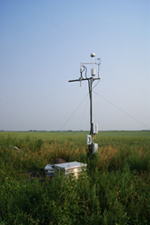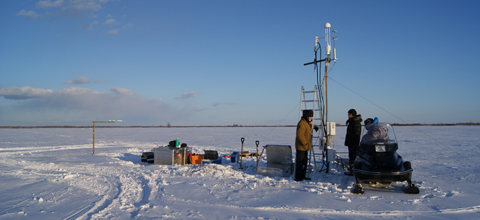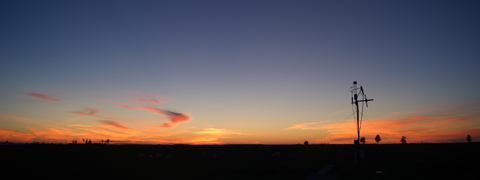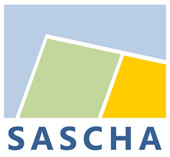Subproject 400
SP 400 - Quantification of Greenhouse Gas Fluxes
Introduction - Objectives - Methods - Results and Materials
Introduction
The interface between the steppe and the northern forest zone in Western Siberia plays a significant role in the global carbon cycle. Induced by a changing climate and by changing socio-economic conditions, agricultural expansion and fundamental land-use changes are expected in these regions. Such changes have a great impact on the budgets of the greenhouse gases (GHGs) carbon dioxide and methane, which are the most important long-lived GHGs in the atmosphere.
Objectives

Station in the oat field
(photo: E. Fleischer)
The goal of this subproject is to quantify and analyze the fluxes of the GHGs water vapor, carbon dioxide, and methane between surfaces of different land-use types and the atmosphere. The processes driving these fluxes will be studied and the potential contribution to global warming will be assessed. Moreover, this subproject aims at identifying feedback-mechanisms between the GHG fluxes on the one hand and climate and land-use change on the other. In synthesis of the obtained results, guidelines will be developed to minimize GHG emissions and to optimize GHG sequestration during the development of land-management strategies.
Methods
The turbulent exchange of the GHGs between the surfaces and the atmospheric boundary layer is directly measured by using the eddy covariance technique. The measurements include the quantification of water vapor, carbon dioxide and methane fluxes, but also the determination of the surface energy balance.
In 2012, one eddy covariance station was operated from mid-July to end of September over a grassland near the city of Tyumen. The grassland was not managed for several years, and usually exhibits very wet soil conditions after snow melt, drying out over the year. However, in the summer of 2012 the soil was extremely dry due to low snow fall in preceding winter. In mid-September, the grassland around the station was ploughed in order to prepare it for food production.
In the current year, 2013, two eddy covariance stations have been being operated in parallel since end of March, which will be continued until beginning of November, over two neighbored study areas, one natural wetland, and one oat field, respectively. This set up allows a direct comparison of the impact of the two different land-use types on the greenhouse-gas fluxes. The chosen study areas are representative for the region so that the obtained data could be used for up-scaling and developing future scenarios.
In addition, all available relevant meteorological data of the region have been collated and processed in order to obtain a detailed picture of the regional variability of the climatic conditions. With the scope of studying the intensity and frequency of climatic extremes in the region in response to global warming, observed as well as projected climate data have been used to compute climate extremes indicators of the Tyumen province.

Setup in the snow. (photo: E. Fleischer)
Results and Materials
Land-use change and its impact on greenhouse-gas fluxes
2012 – Effect of ploughing a grassland on greenhouse-gas fluxes
The fluxes of H2O(g) showed clear diurnal courses with intense evapotranspiration from the surface to the atmosphere during daytime, and a small deposition flux during the nights. (Despite the very low water content of the soil due to the extreme dryness in 2012, the H2O(g) emissions did not increase when the soil was wetted during rainy days. The reason can be found in higher relative air humidities coupled with rain.) An effect of ploughing could not be identified. The smaller fluxes in the period after ploughing are probably due to in average higher relative air humidities.
The CO2 fluxes also showed diurnal courses, mostly with negative fluxes during daytime due to photosynthesis, and emissions during the night because of respiration. Ploughing resulted in positive CO2 fluxes throughout the days because photosynthesis was inhibited. During the whole measurement period a positive CO2 balance was found that was small for the period before ploughing, and highly increased for the period after.
CH4 fluxes were very small over the dry soil and fluctuated around zero. Hence, the grassland could be neither identified as a clear source nor as a clear sink of CH4 during the period of investigation.
Nevertheless, the results indicate that a land-use change from grassland to agricultural used fields imply a positive feedback on climate change.
2013 – Comparison of greenhouse-gas fluxes over a natural and used wetland
Before snowmelt, strongly inhibited, close-to-zero fluxes of the GHGs were detected. After snow melt, at the beginning of April, increased emissions of CO2 and H2O(g) were found. A slight uptake of CO2 during daytime was observed over the vegetated wetland soon after snowmelt, and in the following months, this uptake strongly increased. In contrast, no uptake of CO2 was found over the bare ground of the oat field in the first few months. End of June, with growing of the oat plants, slight uptakes were detected during daytime, and at the beginning of July the uptake has become very similar to that over the wetland. This observation indicates that taking wetlands into agricultural use could enhance climate change.
H2O(g) fluxes were similar over both study areas, but slightly higher over the wetland.
No clear trends or differences in CH4 fluxes could be identified, yet. Due to temporarily inaccessibility of the stations and other problems data losses could not always be avoided, and only a fragmentary data set is available.
Analysis of meteorological data – Climate extremes
The analysis of the collected meteorological data of the Tyumen region regarding climate extremes show that in the past four decades, the coolest night and day temperature increased significantly in winter and summer, respectively. The warmest day and night temperature increased as well, however not significantly. Spring and autumn are the seasons in which significantly increasing trends of the occurrences of warm nights and warm days as well as correspondingly significantly decreasing trends of the occurrence of cool days were found. Cool nights decreased significantly only in autumn. The highest increase was observed for warm days in spring, and the highest decrease was observed for cool days in autumn. Frost and ice days also decreased significantly, while growing season length and growing degree days increased significantly.
No significant trends of precipitation were observed at the regional scale. However, some stations showed significant trends, but they were not consistent across the region.
Projections until 2050 indicate that more warming is yet to come, which will be mainly due to getting less cold rather than getting hotter. The found past and future climate changes can highly affect the ecosystem processes and functions in the region, especially in forest-steppe ecosystem where highest amplitude of climate extremes was found.

Sunset at the wetland station. (photo: E. Fleischer)
Contact
Contact
Prof. Dr. Otto Klemm
Westfälische Wilhems-Universität Münster
Institut für Landschaftsökologie
Heisenbergstraße 2
D-48149 Münster
Tel.: +49 (0) 251 83 33 921
Fax: +49 (0) 251 83 38 338
E-Mail: otto.klemm@uni-muenster.de
Web: http://www.uni-muenster.de/Klima/









